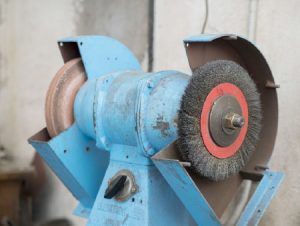 Abrasive wheel machines are used in general industry, construction, and maritime operations, but the small “fixed bench” or pedestal grinders can be found in just about every maintenance and machine shop in America.
Abrasive wheel machines are used in general industry, construction, and maritime operations, but the small “fixed bench” or pedestal grinders can be found in just about every maintenance and machine shop in America.
This adds up to a lot of workers exposed to serious risks for eye injuries, hand or finger injuries or amputations, inhaling grinder generated dusts and fumes, and hearing problems caused by the grinding noise.
OSHA Requirements:
Protective devices keep operators from contacting the sharp metal-removing wheels or debris. OSHA-required protections include:
- Wheel guards are heavy metal hood-like enclosures in alignment with the wheels that cover the spindle end, nut, and flange protections.
- Machine-opening guards protect the operator as the wheel diameter becomes smaller.
- Work rests support the piece being ground and prevent jams or broken wheels. They should be no more than 1/8″ from the wheel.
Inspection and Maintenance Prevent Accidents:
- Operators should inspect the wheels for damage before mounting them. A wheel should be evenly worn without a lot of nicks or scrapes. Check for cracks by tapping the wheel: a clear “ping” means it’s not cracked; a dull thud means it is cracked and shouldn’t be used.
- Check to see that the grinder and the wheel are securely mounted. Be sure electrical cords are properly grounded, the plug has a good connection, and the power transmission motor cover is in place.
Test the wheel before you use it without using materials. Stand off to one side to observe it in use.
ONE BAD DAY AT THE GRINDER COULD RUIN YOUR WHOLE LIFE!!!
Download flyer: STOTW_611_Grinder Safety Download Spanish flyer: STOTW_611_Grinder Safety_esp

